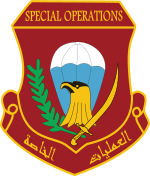Iraqi Special Operations Forces
| Iraqi Special Operations Forces | |
|---|---|
|
ISOF SSI | |
| Active | December 26, 2003 – Present |
| Country |
|
| Branch | Iraqi Army |
| Type | Special Forces |
| Size | 18,000 |
| Part of |
|
| Motto(s) | May you sleep peacefully in your bed tonight for a mighty sword stands ready to strike fear in the hearts of those who would terrorize us! |
| Engagements |
Anti-guerrilla operations in Iraq as part of the Iraq War Iraqi Civil War (2014–present) |
| Commanders | |
| Current commander | Major General Fadhil Jalil al-Barwari |
| Insignia | |
| ICTB Flag |
 |
| ISOF flag |
 |
Iraqi Special Operations Forces (ISOF) (Arabic: قوات العمليات الخاصة العراقية) are Iraqi special forces unit created by coalition forces after the 2003 invasion. The forces, directed by the Iraqi Counter Terrorism Service, consist of the Iraqi Counter Terrorism Command, which has three brigades subordinate to it. The Counter Terrorism Service (Jihaz Mukafahah al-Irhab, originally translated as Counter Terrorism Bureau)[1] is funded by the Iraq Ministry of Defence.
History
Special operations troops in the old Iraqi army were first established when Colonel Khaleel Jassim Al-Dabbagh built the first royal special units in the name of "Queen Alia Forces" in the mid 1950s. It consisted of Sunni, Shia Arabs and other components of Iraqi population. They were mainly used on an emergency basis to carry out special missions inside of Iraq and outside when the country was in war.
After the Invasion in 2003, Iraqi forces were made redundant by the Invasion forces and because of this, the current Iraqi commando force were recruited from scratch, mostly from Shia Arabs, Kurds and few Sunni. In November 2005, after training in Jordan with Jordanian Special Forces and US Army Special Forces ("Green Berets"), the Iraqi Special Operations Force had 1,440 men trained, composed into two combat battalions, considered equal in training and combat effectiveness to an average US Army Infantry battalion, and two support battalions.[2]
In March 2008, the force consisted of a single brigade which in turn was made up of an Iraqi Counter-Terrorism Force (ICTF) battalion, three Commando battalions, a support battalion and a special reconnaissance unit.[3]
In the Battle of Mosul that began in October 2016, the special ops forces were correctly expected to be the first division into the city of Mosul, which has been occupied by ISIL since 2014.[4] On 1 November 2016 the 1st Iraqi Special Forces Division fought its way into the Gogjali quarter of the city, becoming the first Iraqi unit to enter the city during the offensive.[5]
Command structure
The 1st Special Operations Brigade is based in Baghdad and has the 1st, 2nd, and 5th Battalions, a brigade support battalion and a training battalion/Iraqi Special Warfare Center and School. The 1st Battalion is the renamed Iraqi 36th Commando Battalion.[6] The 1st Brigade is often referred to as the Golden Division, and previously the Golden Brigade.[7]
The 2nd Special Operations Brigade has four commando battalions [1,440 men], which were at Basra, Mosul, Diyala and Al Asad prior to the formation of the 3rd Brigade. The battalions at Basra and Mosul achieved Iraqi Operational Control (IOC) in January 2008 and conducted local operations. Regional CT Centers (RCCs), similar to Joint Interagency Task Force (JIATF) organizations, were to be established at all four regional commando bases to develop intelligence on terrorist networks in their region.
The 3rd Brigade was established in Basra by spring 2013, following an order by the prime minister in January 2012 that the forces expand by an additional brigade. It consisted of regional commando battalions in Basra, Diwaniya, Najaf, Maysan, Dhi Qar and Muthana provinces, a recce battalion, and a support battalion.[8]
CT pilot training
In February 2008, the Iraqi Air Force, with Coalition Advisors, began night vision goggle (NVG) training as the basis for future counter-terrorism (CT) pilot training. Potential CT pilots and aircrew will undergo NVG flying introduction in order to select the best pilots for advanced CT aviation training as early as April 2008. Selected pilots will continue to log NVG training hours in order to attain a proficiency level that prepares them for Advanced Special Operations specific training as early as late summer 2008. Once fielded, this special operations aviation capability will reside in the Iraqi Air Force's 15 Squadron,[3]
Gallery
_training_2011.jpg) Members of the Special Forces during training on January 2011
Members of the Special Forces during training on January 2011_training_April_2011.jpg) Members of the Special Forces during training on April 2011
Members of the Special Forces during training on April 2011_participate_in_Lion's_Leap_on_April_26_2011.jpg) Members of the Special Forces participate in Lion's Leap on April 26, 2011
Members of the Special Forces participate in Lion's Leap on April 26, 2011
See also
| Wikimedia Commons has media related to Iraqi Special Operations Forces. |
References
- ↑ Witty, David (2015). The Iraqi Counter Terrorism Service (PDF). Washington, D.C.: The Brookings Institution. p. 10. Retrieved 5 June 2016.
- ↑ "Special Operations: Iraqi Special Operations Forces". StrategyPage. StrategyWorld.com. 17 November 2005. Retrieved 5 June 2016.
- 1 2 Measuring Stability and Security in Iraq - March 2008 Report to Congress
- ↑ Ramsay, Stuart (20 October 2016). "Elite troops strengthen battle for Mosul". Sky News. Retrieved 20 October 2016.
- ↑ "Iraqi Army enters Mosul: Live updates day 16".
- ↑ DJ Elliott, Iraqi Counter Terrorist Bureau (page 8, Iraqi Security Forces Order of Battle), Montrose Toast, information cut-off date 30 November 2009, via Iraqi Order of Battle
- ↑ Witty, David (2015). The Iraqi Counter Terrorism Service (PDF). Washington, D.C.: The Brookings Institution. p. 12. Retrieved 5 June 2016.
- ↑ Witty, David (2015). The Iraqi Counter Terrorism Service (PDF). Washington, D.C.: The Brookings Institution. p. 25. Retrieved 5 June 2016.
